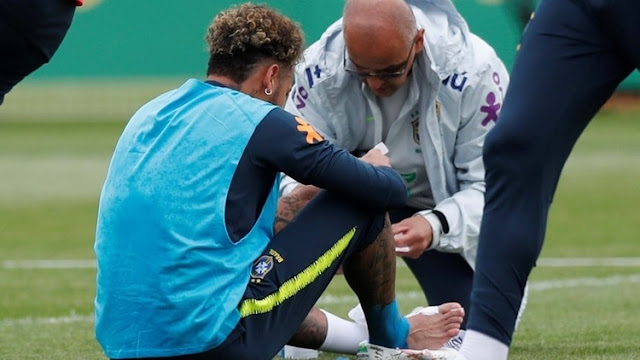Ankle sprain is one of
the most common injuries in contact sports or that involve jumps like
basketball or soccer. The ligament injuries happen generally for an acute
traumastism, rarely occur for overuse. An ankle sprain occurs when the strong
ligaments that support the ankle stretch beyond their limits and tear when we
do an inversion of our foot.
Anatomy
The ankle has 3
ligaments in its external part: anterior talofibular, calcaneofibular,
posterior talofibular. All of them can be injuried, but the common ligament
affected is the first one in a 70% of the time because it is the most exposed
to the stretch.
 |
| Ligaments of the ankle |
Classification of
ligaments injuries
Grade I: Mild. It represents
a microscopic injury without stretching of the ligament on a macroscopic level.
Grade II: Moderate. It
has macroscopic stretching, but the ligament remains intact.
Grade III: Severe. It is
a complete rupture of the ligament.
Treatment
When a ligament is stretched
or broke occurs a vessels constriction around 10-15 minutes followed by an inflammation
caused by increased blood flow to the area in the next 48-72 hours. Furthermore
due the immobilisation, our muscles lost strength and the nervous system miss proprioception
though which we perceive the position and movement of our body, including our
sense of equilibrium and balance. The next treatment will fix these symptoms
and problems.
Acute phase (first
48-72 hours)
R: Rest. Avoid any
activity that may aggravate the injury.
I: Ice. Maintain the
application of cold 20 minutes being able to repeat the operation 3 and 5 times
a day allowing at least 2 hours between each one.
C: Compression.
Elastic tape for to protect the injury.
E: Elevation. Purpose is
to avoid inflammation.
 |
| RICE |
Range of movement
(since 4º-7º day)
Two series of 10
repetitions 2 times per day.
Active: lie on your
back do flexion dorsal, flexion plantar, inversion, eversion and alphabetic
movements (1 minute).
 |
| Active movements without weight |
Isometric: sit down
in a chair do flexion plantar with the other foot on, Inversion, eversion
against a wall and thrusts towards the ground.
 |
| Isometric movements without weight |
Strength (since 15º
day)
Two series of 10
repetitions 2 times per day.
Isometric: stand up
do flexion plantar, Inversion, eversion and thrusts towards the ground
Active: lie on your
back do all movements with a elastic band.
 |
| Active movements with elastic bands |
Proprioception (since
4º week)
Four series of 30
seconds
Walk tiptoe, walk on
heels, lame foot and jumps lame foot. You can complicate these exercises
closing your eyes or stand up over a unstable surface.
 |
| Proprioception exercises |
Final phase (since 6º
week)
If you don´t fell pain
and restrict of range of motion you can jogging and movements in zig-zag
 |
| Zig-zag movements |










No comments:
Post a Comment